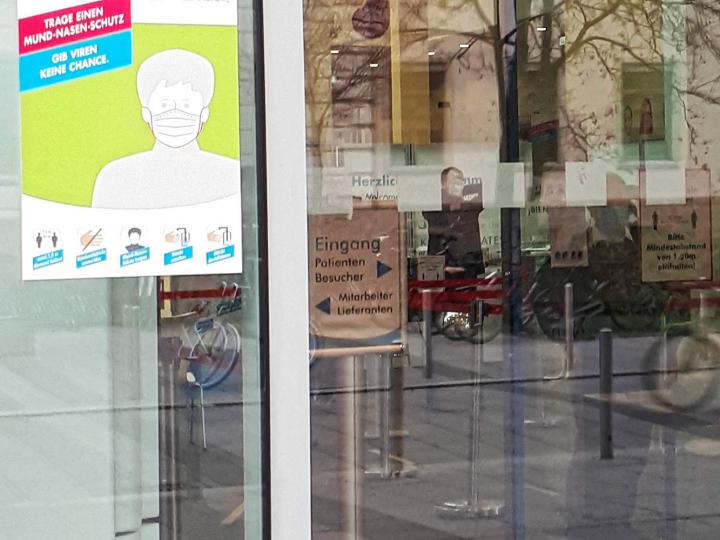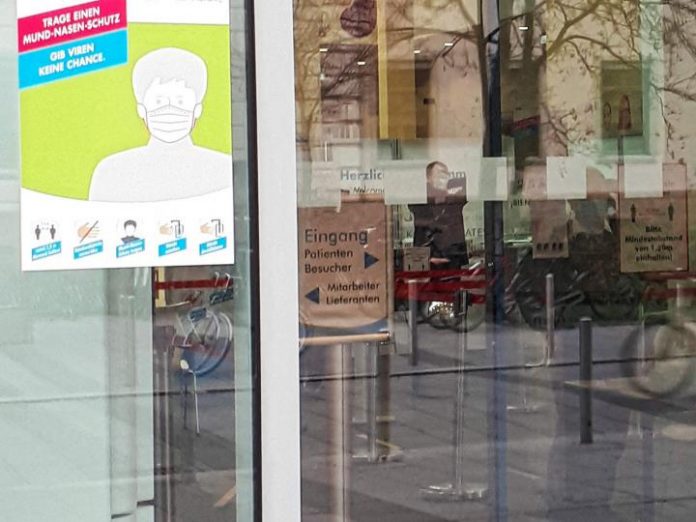
Photo: How can the spread of the SARS-CoV-2 coronavirus be contained in hospitals and nursing homes? Recommendations from an international research team.
view more
Credit Image: Beate Richter, TROPOS
Leipzig/New Delhi/Rome. A variety of measures are necessary to prevent the spread of the coronavirus SARS-CoV-2 in hospitals and nursing homes. It is particularly important to develop an appropriate strategy to protect healthcare workers from airborne transmission. Researchers from the Leibniz Institute for Tropospheric Research (TROPOS) in Leipzig, the CSIR National Physical Laboratory in New Delhi, the Institute of Atmospheric Science and Climate (ISAC) in Rome and 2B Technologies, Colorado recommend that more attention is required in respect to indoor air in such facilities and to further training of the staff. From an aerosol experts’ point of view, it is necessary to combine these different measures, the research team writes in an Editorial article in the International Journal of Environmental Research and Public Health. These include regular ventilation, controlling fresh air consumption via CO2 monitor and using humidifiers to keep the relative humidity indoors at 40 to 60 percent. If it is not possible to ventilate sufficiently, the use of portable air purifiers is also advisable.
The risk of infection is particularly high in hospitals and nursing homes because infected and healthy people stay in the same room for long periods of time and the virus can be transmitted via invisible aerosol particles in the air, even over distances of several metres. According to media reports, COVID-19 infections are already reported in almost one tenth of the 12,000 old people’s homes and nursing homes in Germany. Homes are now also considered as hotspot for the spread of the virus among new infections in Saxony.
Since the outbreak of the pandemic in early 2020, there have been increasing reports of transmissions via aerosol particles in the indoor air of hospitals and nursing homes. These include scientific reports from hospitals in China and the USA, but also from a nursing home in the Netherlands, where the virus apparently spread via the ventilation system using aerosol particles because unfiltered indoor air circulated in a ward. As further evidence, SARS-CoV-2 was detected on the dust filters of the air conditioning system there. “The complexity of the aerosol transmission of SARS-CoV-2, especially indoors, is far from being solved and there is a need to establish appropriate guidelines to protect medical staff. With this publication, we are therefore trying to give recommendations for measures that could contribute to the containment of not only current, but also future virus pandemics”, reports Prof Alfred Wiedensohler from TROPOS.
The aerosol spread of the virus is, according to many experts, a major reason why the number of corona infections in Europe increased dramatically in the autumn. People stay indoors for longer durations and as temperatures fall, many indoor spaces are much less ventilated. Concentrations of viral particles in the air can rise sharply when infected people stay indoors. Simple mouth-nose masks can significantly reduce but not completely prevent the release of viral aerosol particles through the airways. The risk can therefore increase significantly with the number of people and the length of time they stay in the room. Hospitals and nursing homes are particularly affected by this, because additional risk factors are added there: particularly sensitive people, very long stays in a room and sometimes medical procedures such as intubation in intensive care units, where a lot of aerosol is produced.
The spread of viruses via the room air can be reduced with a number of measures. However, there is no single measure that can achieve this completely, but it is important to control indoor air and combine different measures:
“As protection against the transmission of SARS-CoV-2 via the air in closed rooms, especially in cold and dry weather, we recommend humidifiers to keep the relative humidity in the room in the range of 40 to 60 percent and to reduce the risk of respiratory tract infection. It is in this middle range that the human mucous membranes are most resistant to infections. In addition, the viruses in the aerosol particles can survive at a relative humidity around 50 percent for less time than in drier or high humid air,” explains Dr Ajit Ahlawat of TROPOS.
It is very important that there should be a constant supply of fresh air through the air conditioning system or ventilation. This can be controlled with measuring devices for carbon dioxide (CO2). The high CO2 values in indoor places indicate that there is lot of exhaled air in the room. If there is an infected person in the room, then there would also be many viral aerosol particles floating in the air and could be inhaled by a healthy person. The Heating, Ventilation and Air Conditioning (HVAC) system should have a minimum efficiency of MERV-13 to filter even very small particles out of the air. (MERV stands for Minimum Efficiency Reporting Value and is a standard from the USA, established by the American Society of Heating, Refrigerating and Air-Conditioning Engineers (ASHRAE)).
If it is not possible to ventilate the room sufficiently, an attempt can be made to reduce the concentration of viruses in the room air by using air purifiers. However, these air purifiers should have so-called HEPA (High-efficiency particulate absorbing) filters. However, air purifiers can always only be an additional measure as they cannot replace the supply of fresh air and thus oxygen.
Medical staff need special protection during procedures and surgical operations that involve potentially infectious aerosol particles – such as dental treatment or intubation in intensive care units. Valve-free particle filter masks, so-called respiratory masks such as N95, should be worn and care should be taken to ensure that they lie close to the skin. ” Avoid the use of FFP2 and FFP3 type respirators, which have an exhalation valve or ventilation, as these types of respirators are not sufficient. To reduce the risk, protective equipment such as goggles should also be worn,” advises Dr Francesca Costabile of the Institute of Atmospheric Science and Climate (ISAC) in Rome. In addition, the researchers recommend avoiding aerosol-generating procedures and treatments in patients with COVID-19 wherever possible to reduce the risk of infection for medical staff. Aerosol-generating treatments usually include medication administered via a nebulizer. In order to avoid the risk of aerosolisation of SARS-CoV-2 by the nebulisation process, inhaled drugs should be administered by a metered dose inhaler rather than a nebulizer, if possible.
Care should also be taken when disinfecting rooms: “We recommend that disinfection with UV-C light should not be used too often. Although it is known that UV-C light destroys the SARS-CoV-2 viruses, it ultimately increases indoor ozone concentrations and can thus have a negative impact on health if the indoor air is not adequately replaced,” stresses Dr Sumit Kumar Mishra of CSIR – National Physical Laboratory. Spraying oxidizing chemicals in the air, such as hydrogen peroxide (H2O2), can also have negative consequences. Indoors, these chemicals cause toxic chemical reactions that create other air pollutants and damage the central nervous system and lungs of humans.
The international research team emphasises that the training of hospital and nursing home staff is extremely important to prevent the spread of viruses via indoor air. Medical staff must be adequately trained to follow the recommendations. It is important to draw attention to the risks of airborne transmission of SARS-CoV-2. Such recommendations, if adequately provided by health authorities and implemented by medical staff, could significantly reduce the risk of airborne transmission in hospitals and nursing homes until vaccination is effective on a large scale. Tilo Arnhold
###
Publication:
Ahlawat, A.; Mishra, S.K.; Birks, J.W.; Costabile, F.; Wiedensohler, A. Preventing Airborne Transmission of SARS-CoV-2 in Hospitals and Nursing Homes. Int. J. Environ. Res. Public Health 2020, 17, 8553. DOI: 10.3390/ijerph17228553
https:/
Recommendations to prevent airborne transmission of SARS-CoV-2 in indoor environments for winter season based on scientific publications:
https://www.tropos.de/fileadmin/user_upload/Aktuelles/News/Bilder/Bilder_2020/201214_Prevention_from_COVID19_indoor_-_Guidelines_Winter_-_en.pdf
Media contacts:
Prof Alfred Wiedensohler (de.+en.)
Head of the Department Experimental Aerosol & Cloud Microphysics
Leibniz Institute for Tropospheric Research (TROPOS)
Phone +49 341 2717- 7062
https:/
and
Dr. Ajit Ahlawat (en.)
Scientific staff (Post-Doc), Department Experimental Aerosol & Cloud Microphysics
Leibniz Institute for Tropospheric Research (TROPOS)
https:/
https:/
and
Dr. Sumit Kumar Mishra (en.)
Scientist, Environmental Sciences and Biomedical Metrology Division,
CSIR – National Physical Laboratory
Phone +91-11-45609387
http://www.
and
Dr. Francesca Costabile (en. + it.)
Scientist, Istituto di Scienze dell’Atmosfera e del Clima (ISAC)
National Research Council (CNR)
Phone +39 06 4993 4288
https:/
or
Tilo Arnhold
Public Relations at the Leibniz Institute for Tropospheric Research (TROPOS), Leipzig, Germany
Phone: +49-341-2717-7189
https:/
Links:
Corona pandemic could be better tackled by reducing aerosol transmission. Working committee particulate matter (AAF) recommends concrete countermeasures for indoor areas
https:/
Position paper of the Gesellschaft für Aerosolforschung on understanding the role of aerosol particles in SARS-CoV-2 infection
https:/
Coronavirus SARS-CoV-2 spreads more indoors at low humidity
https:/
Support for the appeal of protective measures against the airborne spread of Covid-19
https:/
Exposure to ultrafine aerosol particles in German homes depends primarily on the people themselves (press release, 19 May 2020)
https:/
TROPOS long-term studies for particulate air quality
https:/
UBA Indoor Air Hygiene Commission
https:/















